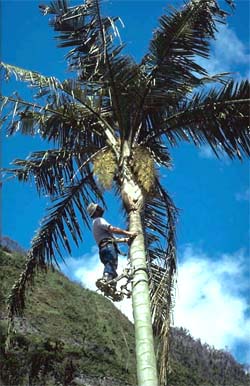Ceroxylon echinulatum Information
Identification:
Stems 5-25 m tall and 15-30 cm diameter, white at base and turning green towards apex, covered with thin layer of wax. Leaves 7-23, forming an almost circular crown; leaflets 55-118 per side, sometimes the apical ones joined at the tips, the lower surface with a very thick whitish or yellowish tomentum. Fruits globose, 1.3-2.2 cm diameter, orange-red exocarp densely covered with prominent, irregular and acute bulges. Identified by prophyll, peduncle, bracts and base of rachis covered with persistent, cream-colored scales, and diagnosed by its very long petiole, leaves arched with pinnae regularly arranged, slightly to completely pendulous; staminate flowers with 9–12 stamens and very long-acuminate petals, and fruits with exocarp densely covered with prominent, irregular and acute bulges.
General Information:
Although it is common in some areas, the survival of this species is threatened by the deforestation of its natural habitat.
Distribution:
Native to, Ecuador, Peru
Western and eastern Andes in Ecuador and Eastern Andes in Peru, in humid premontane and lower montane forest, at 1600-2200 m, in pastures, coffee plantations, crop plots, and remnant forests. It forms populations of hundreds of individuals and apparently it was very abundant in the past. On the eastern Andes of Ecuador there are still extensive populations, especially of old individuals that are left standing in the middle of pastures, but regeneration is usually very abundant near forest patches left along streams.
Location: Ecuador, Peru (-6.552564°N, -76.640625°E)
Observations
Ceroxylon echinulatum Overlay Image ©2026 Trebrown - No re-distribution without permission.

